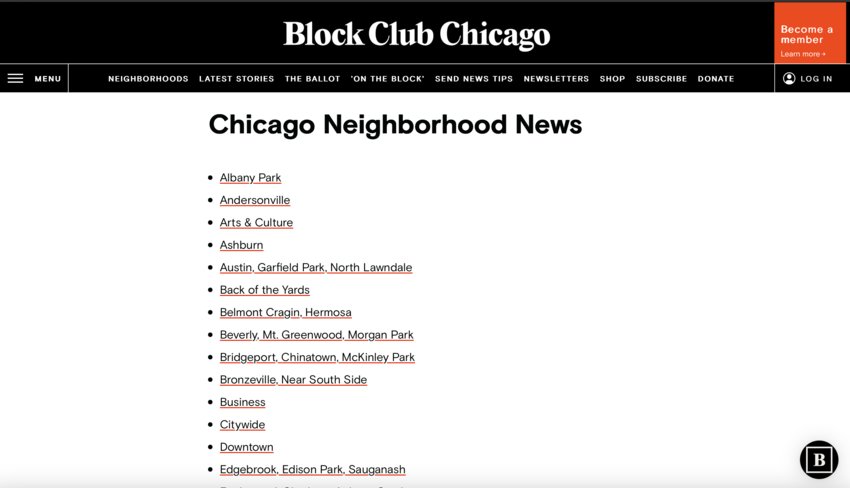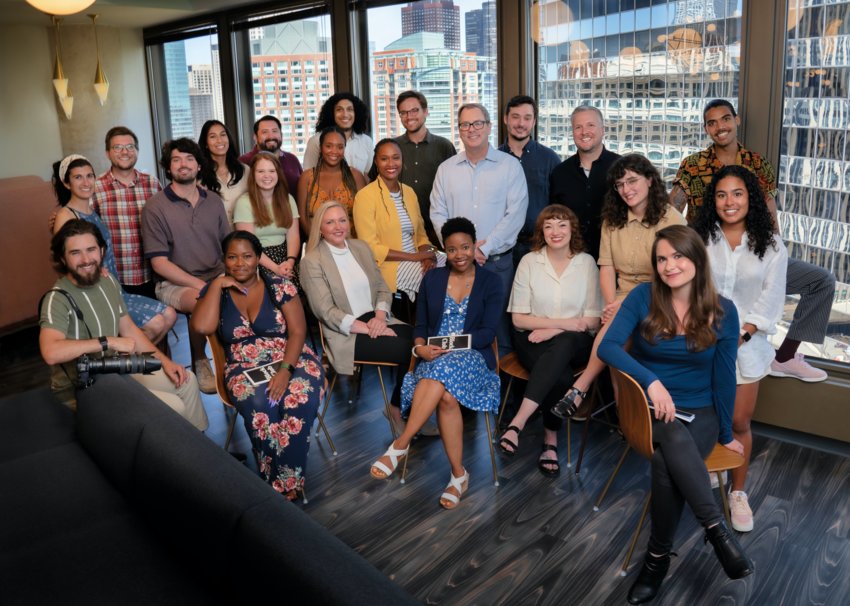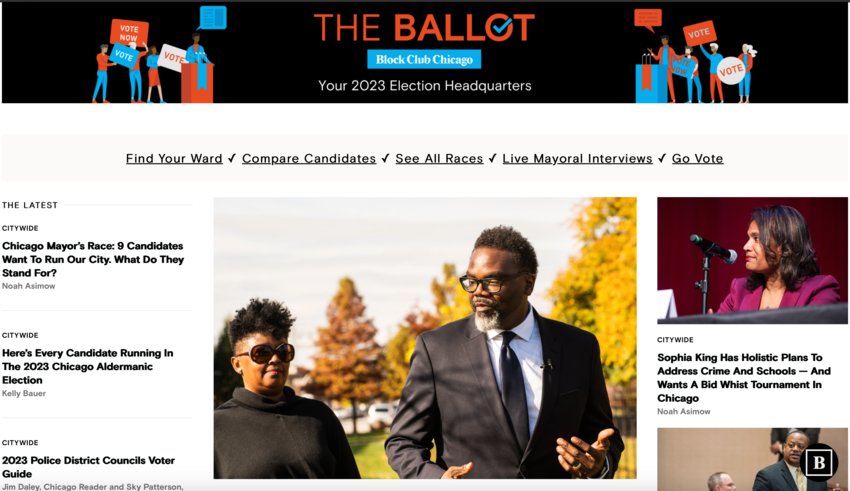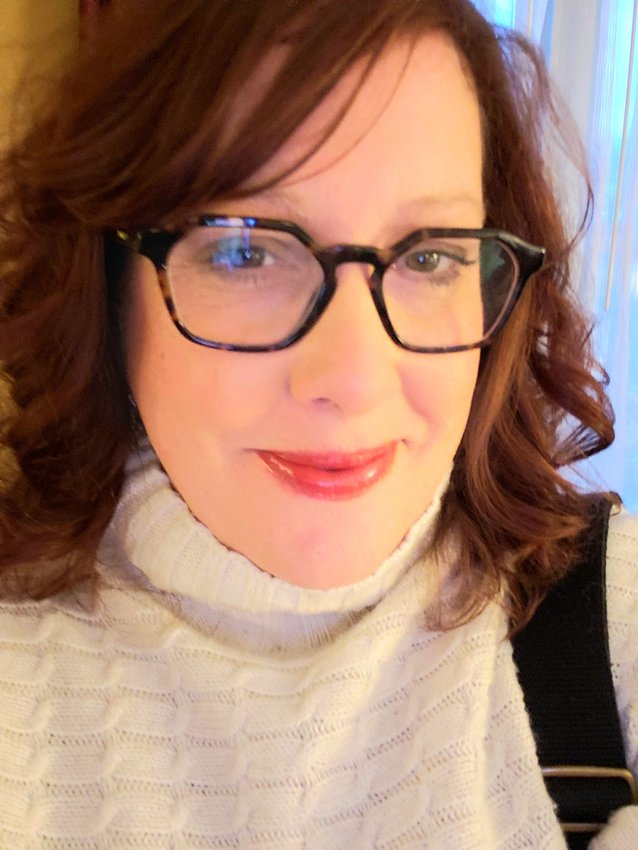Block Club Chicago is celebrating its fifth year as a local news source for the city of 2.697 million. “This is a great time to check in with us,” Stephanie Lulay told E&P in early February. Lulay is the executive editor and co-founder of Block Club Chicago.
With start-up funding from a remarkably successful Kickstarter campaign, Block Club Chicago debuted in 2018 as an independent 501(c)(3), journalist-run newsroom. The mission statement promises 24/7 non-partisan news coverage, which can be about anything of interest and importance to the people of Chicago, generally and on the more nuanced neighborhood-block level.
“Chicago is a city of neighborhoods. That’s our thing, too,” Lulay said.
Today, Block Club Chicago has reporters covering a majority of the neighborhoods across the city, but there are still some “gaps” in community coverage that they hope to fill as the newsroom grows.

“When we launched, we had three editors and five reporters. Today, we have 24 full-time staffers. The bulk of those staffers are editorial, in the roles of reporters and editors,” she said.
E&P asked Lulay what Block Club Chicago seeks in newsroom candidates. She explained that it’s essential to buy into the mission.
“I look for somebody who wants to serve their neighbors,” she expounded. “That doesn't mean that they have to be from the neighborhood they’re covering, though I will share that many of our reporters live in the areas they cover. But they should have a service attitude, someone who really gets what neighborhood or hyper-local news is. They should understand what really matters to people and impacts their lives.”
“We also look for all of the traits you look for in any good reporter,” Lulay added. “They should have an insatiable curiosity and a thirst for understanding how the world works — and who is working it. In a city like Chicago, power plays a big role in everything that happens. … We also look for somebody who sees this as a tremendous opportunity to tell a lot of different kinds of stories.”

Over five years, the Block Club Chicago team and coverage have both expanded.
“We have four full-time reporters focused on neighborhoods on the south side, for example. We have a full-time west-side reporter. … We believe that when you dedicate reporters to cover neighborhoods and build trust with the communities on the ground there, our coverage will be the most accurate and will resonate with readers,” said Lulay.
To complement the BlockClubChicago.org site, the team also produces e-newsletters, a weekly TV show, a podcast and social media channels.
According to the media kit, the majority of Block Club Chicago’s audience is between the ages of 36-45 years old, and 58.5% are women. “Their top interests include the arts, food and wine, technology, travel, home décor and working out,” it reads. Lifestyle stories may resonate with the audience, but these are also readers who appreciate practical information, solutions journalism and a trusted source for investigative reporting.
After a 2022 year-end appeal that inspired approximately 1,000 new paid subscribers, Lulay said their total number of subscribers now exceeds 19,500, and they’d like to reach 20,000 this year.
Block Club Chicago is taking a diversified approach to the revenue model. Annual subscriptions cost $59. Similar to beloved public media appeals, subscribers get a little extra incentive — a neighborhood-honoring print by local artist Steve Shanabruch.
There are two other subscription offers on the signup page, asking members for the $59 annual price plus a little extra, a “rounded-up” donation to $100 or $250.
Block Club Chicago has benefited over the years from philanthropists and grants. They received a $1.6 million three-year grant from the American Journalism Project, allowing them to build a revenue team.
“We are really ramping up advertising here,” Lulay noted. In addition to new advertising revenue, they are also wooing individual donors and corporate sponsorships.
In 2022, they received a $1.6 million grant from the McCormick Foundation expressly for assembling an investigative reporting team and expanding investigative coverage. “We will be building a dedicated investigative team focused on uncovering corruption and inequality and rooting out inequality on the south and west sides of the city. Those are under-resourced neighborhoods in the city that have never really gotten their fair share of media coverage, and our investigative team is going to be solely focused on those stories,” she added.
As the investigative group comes together, Lulay said it's vital that they not be siloed from the rest of the newsroom and that they collaborate with the neighborhood reporters, who are trusted in the community and have a bullpen of go-to sources.
“As we get some of these large grants, we just want to make sure that we keep our readership and our subscribers as a big chunk of our revenue,” she explained.
Focusing on the information subscribers want and need is key to the mission.

“If neighbors care about it, we’re writing about it,” she said. “When new reporters start, I tell them that the job is to figure out what our neighbors care about today and write about it. And that's going to be different every day. It could be a coffee shop opening in the neighborhood or a legacy business closing. It might be a school getting shut down or a new development going up that they don't like. It could be a fight for bike lanes to be installed in a neighborhood or an alderman under investigation for threatening constituents."
Sometimes national news has a local impact on Chicago residents.
“This summer, Chicago was one of the cities that was targeted — because we’re Democrat-run — by Governor Greg Abbott in Texas, who sent busload after busload of migrants here,” Lulay recounted. “That was a national story, but early on, we realized that for us, it would be a local story for a long time to come. These people would be living in our neighborhoods and seeking shelter.”
To comprehensively cover the story, they teamed up with Borderless Magazine, which covers immigration and immigrant communities.
“We decided to find out what happened after the national media moved on. The national headlines portrayed these people like faceless monoliths, but we want to know why they were coming here and what their lives would be like living here as our neighbors,” Lulay said.
Their reporters followed along with 10 Venezuelan immigrants and produced a series called “After the Buses: Meet the Migrants At The Center of Texas’ Manufactured Crisis,” which chronicled their journey.
“It has become a huge local issue, not just because there are 5,000 people here who weren’t here before, but they’re people who need a lot of services,” Lulay said. “We’ve seen local conflict around this, too.”
The week before E&P spoke with Lulay, Chicago’s Mayor Lori Lightfoot had reopened a school in the Woodlawn neighborhood, which had been closed years before, to serve as a shelter for the newcomers.
“That community is an under-resourced community that is primarily Black, so there was conflict around it. People wanted to know why that school hadn't been repurposed earlier as something the community needed. There were actually people blocking the migrants from getting off the buses. So, you see, these national issues do become local issues and vice versa,” she said.
Last year, Block Club Chicago received two awards from the LION Publishers Local Journalism Awards — for Outstanding Coverage and Revenue Campaign of the Year. In 2021, Block Club Chicago was LION's Publisher of the Year and was the past recipient of an E&P EPPY Award for Best News Site.
“I’m very proud that the staff has been honored with awards. But we really do this for our readers. I’m most proud to be significantly supported by our readers. To me, every single person who subscribes feels like an award because you have won that person over. They have entrusted you to inform them, and that’s huge in this day and age.”
 Gretchen A. Peck is a contributing editor to Editor & Publisher. She’s reported for E&P since 2010 and welcomes comments at gretchenapeck@gmail.com.
Gretchen A. Peck is a contributing editor to Editor & Publisher. She’s reported for E&P since 2010 and welcomes comments at gretchenapeck@gmail.com.
Comments
No comments on this item Please log in to comment by clicking here